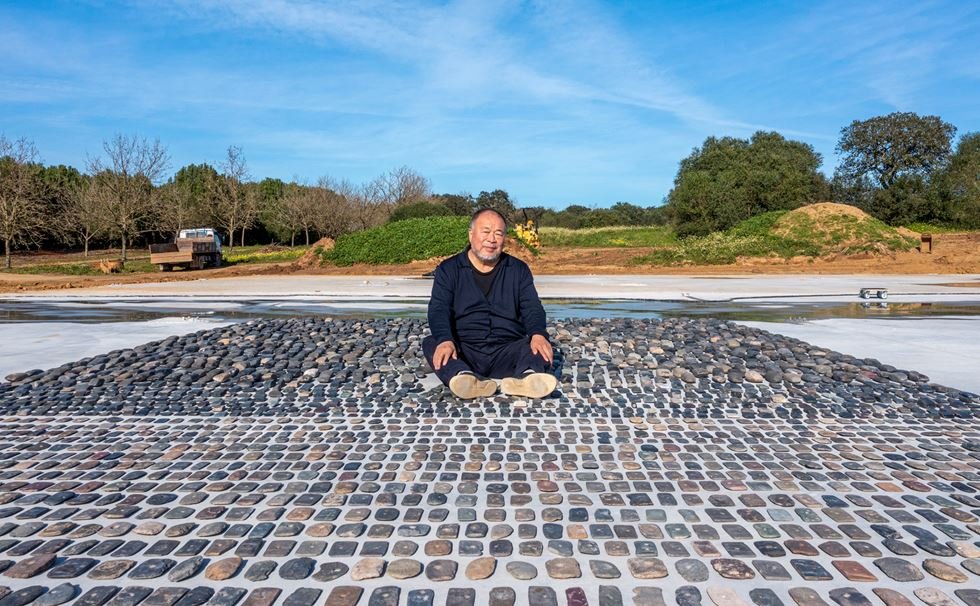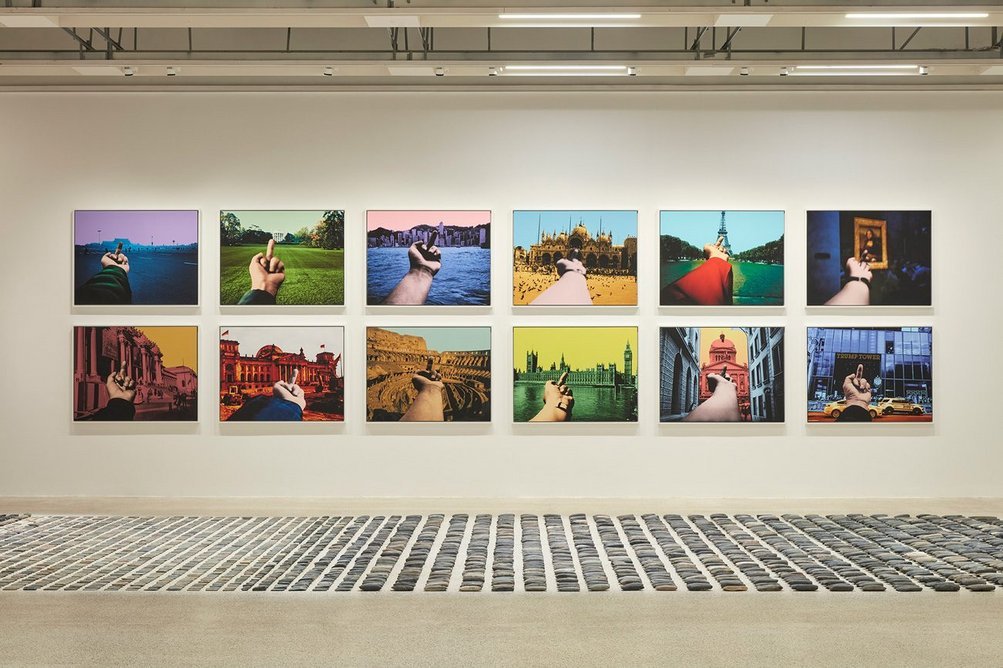Not one to shy away from political statements, Chinese artist and activist Ai Weiwei’s recent exhibition questions mass production and highlights human rights tragedies around the world.
Ai sits atop “Still Life,” one of the works presented in Making Sense consisting of 1,600 tools from the late Stone Age. Ai Weiwei Studio. CC BY-NC 2.0
Internationally renowned Chinese artist Ai Weiwei is known for his ability to present political opinions and insights through artwork that relies heavily on everyday objects, and his latest exhibit is no different. Titled “Making Sense,” the exhibit, which has been on display at London’s Design Museum since April 7 and will remain there until July 30, includes a number of Ai’s decommissioned artworks as well as a handful of new pieces. This exhibit marks the first time Ai has offered commentary on the practice of design and what it means for the value society places on objects.
Ai Weiwei pictured talking to reporters outside of his studio soon after his release from detainment in 2011. Getty Images. CC BY-SA 2.0
While Ai is most widely known as an artist, he is also an internationally recognized human rights activist due to the strong political statements he makes both through his art and his speech. He has long been openly critical of the Chinese government’s stance on the democratic process and human rights, which led to a stint under house arrest in 2010. The government claimed that he had built his Shanghai studio illegally and scheduled it to be demolished, although many believed that this was simply an excuse to further crackdown on dissent.
Ai has also regularly conducted investigations into government corruption and scandals which were covered up, resulting in his arrest in April of 2011 due to “economic crimes”. He was detained for a total of 81 days without ever being charged, and upon release, was hailed as the father of modernism in China. His clashes with the Chinese government have meant that freedom of expression and free speech are central themes to a lot of his work, and he often tries to draw parallels between his experiences in China with what he sees happening in the US, Europe, and elsewhere.
Photographs from the “Study of Perspective” collection are displayed above the stone age tools. Ed Reeve. CC BY-NC-ND 2.0
In “Making Sense,” many of the works are large collections of objects both ordinary and rare, meant to probe his audience’s views on mass production and consumption, from lego bricks to stone-age tools, pottery shards to porcelain cannonballs from the Song dynasty (960 - 1279 CE). True to his activism, there are also a number of works highlighting various human rights and social justice issues, such as the poor response of the Mainland Chinese government after the Sichuan earthquake in 2008 and the ongoing refugee crisis in Southern Europe.
Among the decommissioned works in the exhibit is a collection of photographs titled “Study of Perspective,” in which only Ai’s hand is seen emerging from behind the camera, holding up his middle finger before a variety of backgrounds including the Eiffel Tower, Tiananmen Square, and the White House. Shot between 1995 and 2017, these photographs were meant to mimic those taken by tourists in front of these popular landmarks, while simultaneously presenting a sharp statement of opposition to the political institutions they represent.
A sea of donated lego bricks makes up the “Untitled (Lego Incident)” Work in the exhibit. Ed Reeve. CC BY-NC-ND 2.0
Another work, “Untitled (Lego Incident),” comprises hundreds of Lego pieces donated to Ai after Lego refused to sell him any of their products in 2014. He had been previously been using Lego bricks to create portraits of imprisoned human rights activists to display as part of his “@Large” exhibit displayed in the infamous prison on Alcatraz Island, but Lego blacklisted Ai, announcing that their products are not meant to be used for political messages. His response on social media resulted in these donations, with this exhibition the first time the Legos will be part of a formal production. This field of bricks lies in front of another Lego based artwork in which Ai has reinterpreted the famous Monet painting of water lilies, using over 650,000 individual bricks to create a wall piece which stretches for almost 50 feet (roughly 15.2 meters).
Some of the works are of a much more personal nature, such as “Left Right Studio Material,” a carpet of blue glazed pottery shards leftover from when the Chinese government raided Ai’s studio in 2018 demolishing everything they could find. At the time Ai had been experimenting with the ceramics, trying to create the largest possible sphere that would fire in his kiln without shattering. One such bubble is visible to the right of the shards, a lone survivor of the studio raid. This work is one of a handful that speak to Ai’s fascination and appreciation of artisanal Chinese craftwork, porcelain making being among many that are quickly dying out thanks to automated mass manufacturing processes.
A close-up view of the porcelain teapot shards that comprise “Spouts”. Ian Mansfield. CC BY-SA 2.0
In this vein, the two works “Untitled (Porcelain Balls)” and “Spouts” also pay homage to Chinese porcelain, the former a field of over 200,000 porcelain cannonballs from the Song Dynasty; Ai was shocked by the use of such a delicate material to make ammunition. The latter is a collection of over 250,000 porcelain spouts broken off of teapots that were not perfect enough to be sold. These massive collections have been curated by Ai himself since the 90s and aim to question how we decide what objects are worthy of value: each of the cannonballs or stone age tools could be placed in a museum given their historical significance, but Ai was able to find them for next to nothing in Chinese flea markets.
“Backpack Snake” (left) and “Life Vest Snake” (right) adorn the back wall of the exhibit. Ed Reeve. CC BY-NC-ND 2.0
Conversely, the two winding snakes on the back wall of the exhibit are dedicated to the victims of the Sichuan earthquake in 2008 and the refugees who lost their lives making the journey to Europe from Syria. Titled “Backpack Snake” and “Life Vest Snake” respectively, each work uses items the artist found at the site of both crises: children’s backpacks collected from the rubble of the earthquake and life jackets left on shores of Lesbos by Syrian refugees. Ai painted over and repurposed these objects into the two 55 feet (roughly 16.8 meters) long serpents, which, to Ai, symbolize the complexity and unpredictability of crises both natural and man-made.
As of 2021, Ai has been living in Portugal and is still working in his new home in Montemor-o-Novo, a small countryside town near the Southwest Coast. His new work continues to draw inspiration from his Chinese roots as he collaborates with local ceramicists and porcelain makers to produce new art.
Tanaya Vohra
Tanaya is an undergraduate student pursuing a major in Public Health at the University of Chicago. She's lived in Asia, Europe and North America and wants to share her love of travel and exploring new cultures through her writing.








